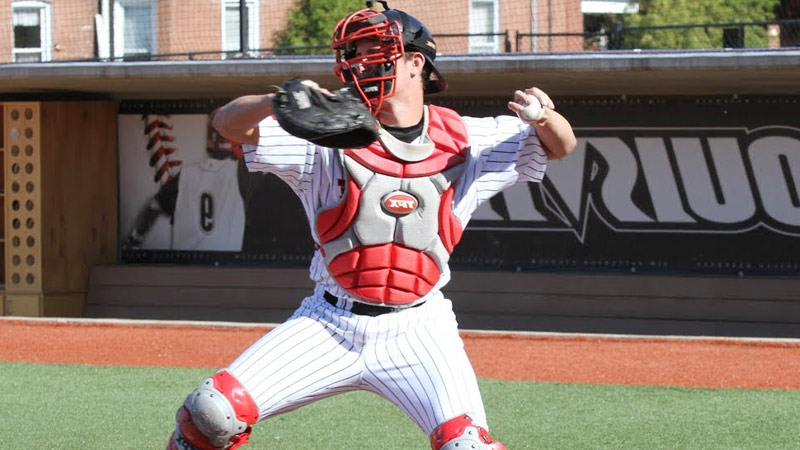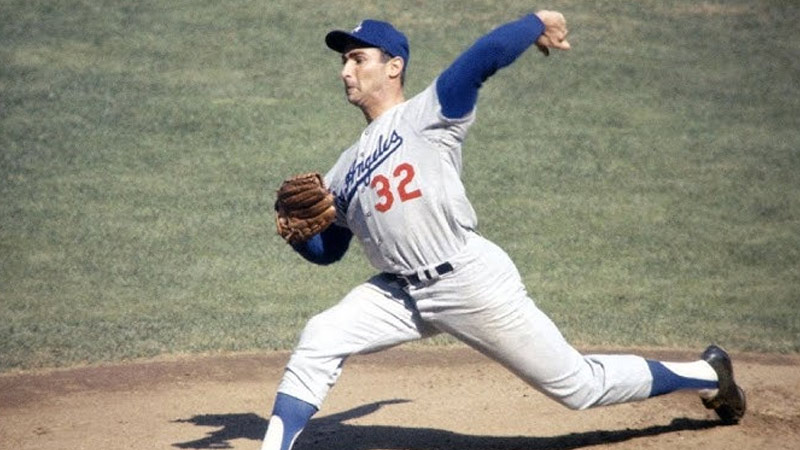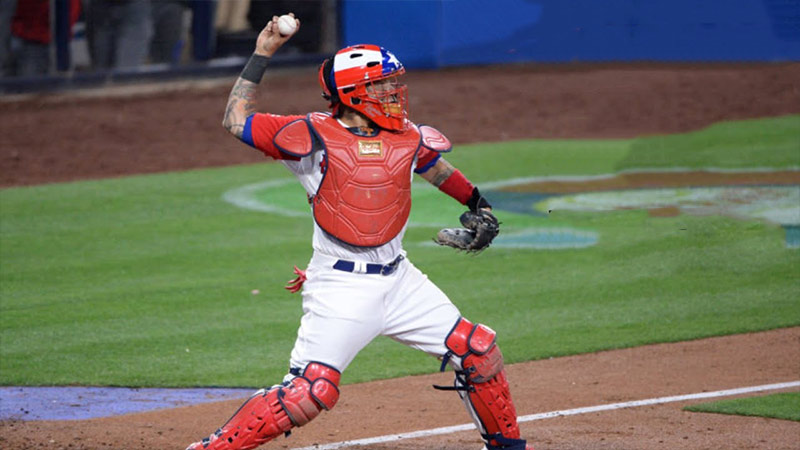Baseball is a sport rich in tradition and folklore, where positions have evolved over the years to create a dynamic and well-structured game.
However, if you’ve ever wondered why left-handed catchers are a near-mythical entity in the world of baseball, you’re not alone.
In this exploration, we delve into the fascinating world of baseball’s most unusual position, uncovering the historical, practical, and strategic reasons behind the scarcity of left-handed catchers in the Major Leagues.
From the mechanics of throwing to second base, to the unique challenges at home plate, this article unravels the mysteries surrounding the absence of left-handed catchers and why they are so rare in a game defined by its traditions and positional conventions.
Join us on this journey to understand the unorthodox and unconventional, yet captivating, world of left-handed catchers in baseball.
What Hand Catchers Use in Baseball?
In baseball, catchers use a specific type of glove known as a catcher’s mitt or catcher’s glove. This glove is designed to help catchers handle fast-moving pitches and protect their hands while receiving the ball.
Here are some key features of a catcher’s mitt:
Size and Shape
A catcher’s mitt is larger and has a distinct shape compared to gloves used by other players on the field. It is heavily padded and has a deep pocket to make it easier to catch and control pitches.
Padding
Catcher’s mitts have extra padding to help absorb the impact of high-velocity pitches. The padding also helps protect the catcher’s hand and fingers from injury.
Closed Webbing
Most catcher’s mitts have closed webbing, meaning there is a solid piece of leather or fabric between the thumb and index finger. This design is intended to provide extra support and control when catching pitches.
Strong Wrist Strap
Catcher’s mitts have a strong and adjustable wrist strap to ensure a secure fit on the catcher’s hand and prevent the mitt from coming off during play.
Deep Pocket
The deep pocket in the mitt is designed to securely hold the baseball, making it easier for the catcher to control and transfer the ball quickly for throws to other players.
Catcher’s mitts are essential equipment for catchers, as they need to effectively catch and control a wide variety of pitches, including fastballs, breaking balls, and off-speed pitches.
The design of the mitt helps them do this while also protecting their hand from the impact of the ball.
Why Are There No Left-Handed Catchers in Baseball?

Many people think about why are there no lefty catchers. There are very few left-handed catchers in baseball, and they are a rarity for several practical reasons:
Throwing to Second Base: One of the primary duties of a catcher is to quickly and accurately throw the ball to second base to try and catch potential base stealers.
The majority of baseball players are right-handed, including the pitchers.
If a lefty catcher were to catch a pitch and then try to make a throw to second base, they would need to turn their body to make the throw, which takes more time compared to a right-handed catcher who can throw more directly.
This extra time could allow baserunners to steal bases more easily.
Play at Home Plate
A right-handed catcher can more easily tag a runner sliding into home plate with their glove on their left hand. For a left-handed catcher, this maneuver would be more awkward.
Baseball Equipment
Catcher’s gear, including the catcher’s mitt, chest protector, and shin guards, is predominantly designed for right-handed catchers.
Left-handed catchers would need specially designed equipment, which may not be as readily available.
Rare Skill Set
Catching is a highly specialized position, and being a left-handed catcher is not common because the physical demands and the required skills for the position often favor right-handed players.
It’s more challenging to find left-handed individuals who possess the necessary skills and experience to become catchers.
While it’s technically possible for someone to play as a left-handed catcher, it would require significant adjustments in terms of training, equipment, and tactics.
As a result, left-handed catchers are extremely rare in professional baseball, and it’s not a position that is encouraged for left-handed players due to the practical challenges involved.
Most left-handed players are utilized at other positions, such as pitcher, first base, or the outfield, where their handedness doesn’t pose the same challenges.
Are There Any Left-Handed Catchers in MLB?

There were no left-handed catchers in Major League Baseball (MLB). Left-handed catchers are exceptionally rare in professional baseball due to practical considerations and historical conventions.
Catchers are predominantly right-handed because their position requires quick and accurate throws to second base to prevent base stealers.
Being a left-handed catcher would necessitate an unorthodox throwing motion and make it more challenging to perform essential aspects of the position, such as tagging runners at home plate.
While it is theoretically possible for a left-handed player to become a catcher, the logistical challenges and the scarcity of such individuals in the professional ranks have made it highly unusual.
It’s essential to check the most recent MLB rosters or news for any potential developments, but left-handed catchers remain a rarity in the league as of my last update.
Why Are Catchers Right-Handed in Baseball?
Catchers in baseball are predominantly right-handed because of the historical and practical factors that have shaped the game over time. Here are some of the key reasons why right-handed catchers are the norm:
Throwing to Second Base
Catchers often need to make quick and accurate throws to second base to try to catch baserunners attempting to steal.
Since the majority of baseball players are right-handed, including the pitchers who deliver the pitches, it is more efficient for a catcher to have their glove on their left hand to quickly transfer the ball and make an accurate throw to second base.
Throwing to Third Base
In addition to throwing to second base, catchers also need to make throws to other bases, including third base.
A right-handed catcher can more easily make throws to third base because their throwing arm is already in position for such a throw.
Right-Handed Dominance
Throughout baseball’s history, the majority of players have been right-handed. This has influenced the development of the game and the positions players typically play.
Standard Equipment
Catcher’s gear, including the catcher’s mitt, chest protector, and shin guards, is primarily designed for right-handed catchers. The design of the mitt, in particular, is optimized for a right-handed throw.
Traditional Role
Over time, right-handed catchers have become the traditional and accepted standard in baseball.
Left-handed catchers would require specialized equipment and would need to adapt to the predominantly right-handed nature of the game.
While left-handed catchers are extremely rare in professional baseball, the tradition of right-handed catchers is deeply ingrained in the sport.
Also, the practical advantages of a right-handed catcher position make it unlikely that this will change significantly in the future.
Best Left-Handed Baseball Players of All Time

Determining the “best” left-handed baseball players of all time can be subjective, as it depends on various factors such as position, era, and personal preferences.
However, here is a list of some of the most notable and accomplished left-handed baseball players in the history of the sport:
Babe Ruth
A legendary figure in baseball, Babe Ruth was a left-handed hitter and pitcher known for his incredible power and home run records. He is often considered one of the greatest players of all time.
Sandy Koufax
Koufax was a dominant left-handed pitcher for the Brooklyn and Los Angeles Dodgers in the 1950s and 1960s. He won multiple Cy Young Awards and is renowned for his incredible strikeout and no-hitter performances.
Ted Williams
Williams was a left-handed hitter and played as an outfielder for the Boston Red Sox. He is widely regarded as one of the greatest hitters in baseball history and was the last player to achieve a .400 batting average in a season.
Randy Johnson
Known as “The Big Unit,” Johnson was a left-handed pitcher who had a long and successful career with several teams, including the Seattle Mariners, Arizona Diamondbacks, and New York Yankees.
He was known for his dominating fastball and tall stature.
Clayton Kershaw
Kershaw, a current player for the Los Angeles Dodgers, is one of the most dominant left-handed pitchers of his era. He has won multiple Cy Young Awards and is known for his exceptional control and breaking pitches.
Warren Spahn
Spahn was a left-handed pitcher who spent much of his career with the Boston and Milwaukee Braves. He won 363 games, the most by a left-hander in MLB history, and was a 17-time All-Star.
Steve Carlton
Carlton was a Hall of Fame left-handed pitcher who had a remarkable career with various teams, most notably the Philadelphia Phillies. He won four Cy Young Awards and ranks among the all-time strikeout leaders.
Eddie Collins
Collins, a second baseman, played in the early 20th century and is often considered one of the greatest infielders in baseball history. He was a part of multiple World Series-winning teams.
Reggie Jackson
Though known for his power-hitting as a right fielder, Reggie Jackson was a left-handed batter and one of the most clutch hitters in baseball history. He had a stellar career and was a key contributor to several World Series-winning teams.
David Price
A left-handed pitcher who has had a successful career with various teams, including the Tampa Bay Rays, Boston Red Sox, and Los Angeles Dodgers.
He has won a Cy Young Award and played a significant role in World Series championships.
These are just a few of the many left-handed baseball players who have made significant contributions to the sport.
The best left-handed players can vary depending on personal opinions and specific criteria, but these players are often celebrated for their achievements and impact on the game.
FAQs
How many left-handed catchers in MLB?
There have been very few left-handed catchers in MLB history, with just a handful recorded in the entire history of the league.
Why no left-handed catchers is there in Baseball?
Left-handed catchers are extremely rare due to the unconventional nature of the position, as a lefty catcher would have difficulty making throws to third base, particularly during steals. The mechanics of the position favor right-handed catchers.
Are there left-handed catchers in MLB?
While left-handed catchers are rare, there have been a few instances of them in MLB history, but they are exceptions rather than the norm.
Why are catchers right-handed in Baseball?
Catchers are predominantly right-handed in baseball because it is easier for them to make throws to second and third base, which are crucial for defending against base stealers.
This traditional setup has been maintained for efficiency and defensive effectiveness.
Who are the best lefty catchers in the MLB?
Left-handed catchers are exceedingly rare, making it difficult to identify a list of “best” lefty catchers in MLB. The position’s demands and convention heavily favor right-handed catchers, so they are the predominant choice for the role.
Wrapping Up
In the realm of baseball, tradition and practicality often reign supreme, resulting in the scarcity of left-handed catchers.
While left-handed individuals may excel in various positions on the field, becoming a catcher requires breaking with convention.
The need for rapid throws to second base, the nuances of tagging runners at home plate, and the lack of equipment designed for left-handed catchers make it a challenging role.
In the end, the rarity of left-handed catchers adds a touch of mystique to the sport, reminding us of the enduring traditions that shape the game.
While baseball continues to evolve, certain aspects remain firmly rooted in history, and the absence of left-handed catchers is a testament to the enduring legacy of the sport.







